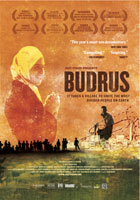
Budrus 2009
Distributed by Ro*co Films International, llc, 80 Liberty Ship Way, Suite 5, Sausolito, CA 94965; 415-332-6471
Produced by Ronit Avni, Julia Bacha, Rula Salameh
Directed by Julia Bacha
DVD, color, 75 min.
Sr. High - Adult
Middle Eastern Studies, Women’s Studies, Media Studies, Multicultural Studies, International Relations, Jewish Studies, Military Studies
Date Entered: 02/18/2011
Reviewed by Winifred Fordham Metz, University of North Carolina at Chapel HillBudrus, a small Palestinian agricultural village known for cultivating olives, is situated northwest of Ramalllah in the northern West Bank. The approximately 1,500 people who live in Budrus depend heavily on the income that their olive tree groves generate. When villagers learn that the planned route of the Israel Separation Barrier will uproot a large number of their trees as well as cut off access to other areas of their farmland and village cemetery, they quickly form a protest.
Central to the organization of the protest are a father and daughter team, Ayed and Iltezam Morrar. After witnessing a few days of unsuccessful protest attempts (bulldozers uprooted dozens of olive trees), 15-year-old Iltezam approached her father with the assertion that the group would find better result if it included the women and girls of the village. Ultimately, what made this protest unique was not only its employment of a decidedly nonviolent approach, but the variety of participants who joined the peaceful protest; both local Hamas and Fatah groups, the teenage girls and women of the village, as well as Israeli and international activists.
Filmed primarily in 2003 and 2004, director Julia Bacha weaves together more than 10 months of footage following Ayed’s diligent planning, the gradual addition of each of the unlikely groups to the village’s cause, as well as numerous interactions between the assembled protestors and the Israeli army members sent to maintain the construction of the Separation Barrier. Here, Bacha spends time laying out various relationships between the groups. She follows Ayed as he carefully solicits support from local Hamas and other Fatah leaders and later, as he tries to enlist broader Palestinian governmental support. She also focuses on numerous interactions between the female protesters and one of the chief Israeli female officers assigned to the village, Yasmin. And, Bacha closely chronicles the addition of the Israeli activists—and the effect this has on the villagers and army members.
At the close of 55 demonstrations, Ayed and the other protestors see result. The olive groves remain intact and the Israeli government moves the Separation Barrier around Budrus almost entirely back along the green line. Ayed confirms that he, the villagers and other helpful protesters were able to save 95 percent of their farmland and access to their cemetery.
As interesting as Budrus is, there is some concern over contextual information, including a vague timeline of events. In addition, objectivity is inconsistent and there is a lack of critical commentary on the result of the protest. Ultimately, the merit of the film lies in presenting this somewhat unique example of non-violent protest and unification between the women, men, Hamas, Fatah, Palestinian, Israeli and international protestors.
This film would find use related to the study of the Middle East, women’s studies, media studies, multicultural studies, international relations, Jewish studies, and military studies. It could easily be used in high school classrooms and higher to motivate discussions on these and other similar topics.
Awards
- Winner, Special Jury Mention, Tribeca Film Festival, 2010
- Winner, Audience Award, San Francisco International Film Festival, 2010
- Winner, Witness Award at Silverdocs Film Festival, 2010
- Winner, Panorama Audience Award, Berlin International Film Festival, 2010